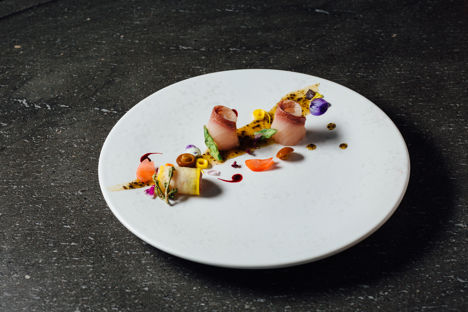
4 of the best yellowtail recipes
Yellowtail may not be a fish that’s particularly well-known in the UK but it’s actually incredibly versatile and most importantly delicious. These four amazing yellowtail recipes are a great place to get started.
4 of the best yellowtail recipes
Yellowtail may not be a fish that’s particularly well-known in the UK but it’s actually incredibly versatile and most importantly delicious. These four amazing yellowtail recipes are a great place to get started.
Just five species - cod, haddock, tuna, salmon and prawns - account for the vast majority of seafood consumed in the U.K. This has had devastating impacts on wild populations of fish, both through overfishing and bycatch. For anyone looking to branch out and try some less well known and more sustainable options, yellowtail kingfish (Seriola lalandi) is a seriously tasty place to start.
Kingfish, also known as yellowtail amberjack and by its Japanese name, hiramasa, is an fatty fish found in the Southern Hemisphere. Despite being relatively unknown in the U.K. kingfish is a highly delicious and versatile fish, and can be used in a wide range of different cuisines and dishes. When cooked the flesh is buttery and firm, perfect for grilling and roasting. When served raw as nigiri or sashimi, it is delicate and sweet, and pairs well with citrus. One yellowtail dish you might have heard of is Nobu’s famous yellowtail sashimi which comes topped with thin slices of jalapeno.
As well as being delicious, farmed European kingfish is sustainable and has been awarded the highest certificate of sustainability - “Best Choice” - by the MSC. Although no aquaculture system is perfect, yellowtail kingfish can be farmed using the most environmentally friendly aquaculture method, the “recirculating aquaculture system” or RAS. Farms using this system keep fish in large tanks on land, where the water is constantly cleaned, filtered and then reused. Using a closed system like this reduces the risk of contaminating oceans, and minimises the amount of water needed to raise the fish. Baby fish are also raised from eggs in hatcheries, rather than caught from the oceans, so wild stocks of fish aren’t depleted. All of this makes yellowtail kingfish a fantastic choice for your dinner table - here are a few recipes for making the most of it.
Kappa meen – Kerala yellowtail curry with mashed tapioca
In this kappa meen (tapioca fish) recipe, Alfred Prasad brings together two Keralan staples: fish and tapioca, or kappa as it’s called in Malayalam. Prasad serves the yellowtail kingfish with plenty of kudan puli, or Malabar tamarind, as well as fried shallots and fresh curry leaves. Yellowtail kingfish makes a fantastic choice for Keralan fish curries, since it can stand up to longer cooking times and stronger flavours like tamarind and curry leaves. Fresh tapioca - rather than the small, dried pearls found in the U.K. - is a popular breakfast dish in Kerala, typically paired with a fish or meat curry.
Yellowtail with red dulse, olive oil and soy
This dish by Phil Fanning brings together Japanese and British flavours - miso and beetroot sorbet, red dulse braised with soy, and damson flowers and micro shiso. The highlight of the recipe is the yellowtail, briefly marinated in a ginger, sesame and soy dressing. The marinated fish is served with long, thin threads of daikon radish, which is a traditional sashimi garnish or tsuma in Japan. This recipe is typical of Phil Fanning’s style, which combines Japanese and local ingredients in highly technical and complex dishes.
Yellowtail nigiri
Hideki Hiwatashi’s recipe for seared yellowtail nigiri is minimalistic, simply pairing shiso-topped nigiri with tart pickled ginger and wasabi. Hiwatashi, former-executive chef of Sake no Hana, and the renowned three Michelin star Kikunoi in Kyoto, lightly chars slivers of yellowtail with a blowtorch to give each bite a gently smoky flavour. Although the topping - or neta - of nigiri is most frequently served raw, some types of fish such as yellowtail are traditionally lightly grilled, pickled or scalded before serving.
Hamachi usuzukuri – yellowtail sashimi with truffle ponzu
This dish by Hideki Hiwatashi pairs yellowtail usuzukuri sashimi with a colourful array of pickled courgette, asparagus spears and red radishes. Hiwatashi rolls up the slivers of yellowtail so that they resemble roses, and then drizzles them with an extravagant yuzu, truffle and black pepper sauce. Usuzukuri is a way of cutting sashimi into delicate, paper-thin slices. It is a traditional method of serving white-fleshed fish such as hirame or yellowtail that makes for a dramatic and beautiful starter at a dinner party. Slicing fish this thin requires a very sharp knife, and a steady hand, in order to make sure each piece is an even thickness.


